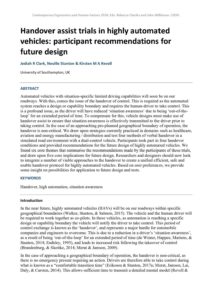| Document | Author Jediah R Clark, Neville Stanton & Kirsten M A Revell |
| Abstract Automated vehicles with situation-specific limited driving capabilities will soon be on our roadways. With this, comes the issue of the handover of control. This is required as the automated system reaches a design or capability boundary and requires the human-driver to take control. This is a profound issue, as the driver will have reduced ‘situation awareness’ due to being ‘out-of-the-loop’ for an extended period of time. To compensate for this, vehicle designs must make use of handover assist to ensure that situation awareness is effectively transmitted to the driver prior to taking control. In the case of an approaching pre-planned geographical boundary of operation, the handover is non-critical. We draw upon strategies currently practiced in domains such as healthcare, aviation and energy manufacturing / distribution and test four methods of verbal handover in a simulated road environment with a dual-control vehicle. Participants took part in four handover conditions and provided recommendations for the future design of highly automated vehicles. We found six core themes that summarise the recommendations made by the participants of these trials, and draw upon five core implications for future design. Researchers and designers should now look to integrate a number of viable approaches to the handover to create a unified efficient, safe and usable handover protocol for highly automated vehicles. Based on user preferences, we provide some insight on possibilities for application to future design and tests. |

